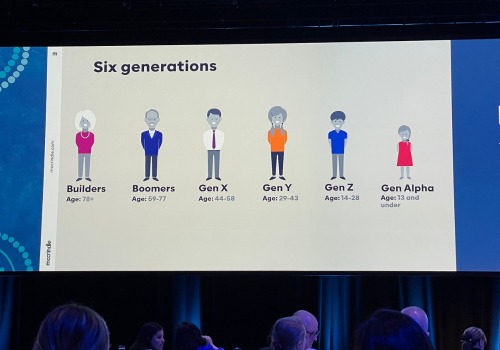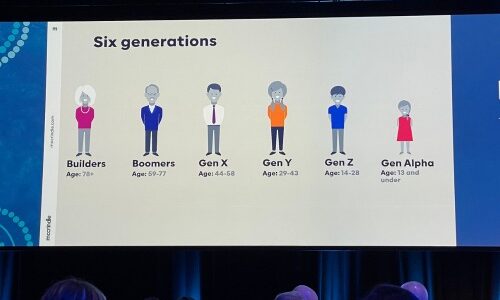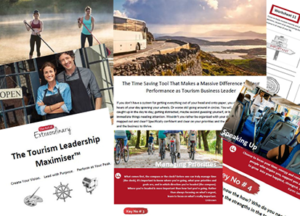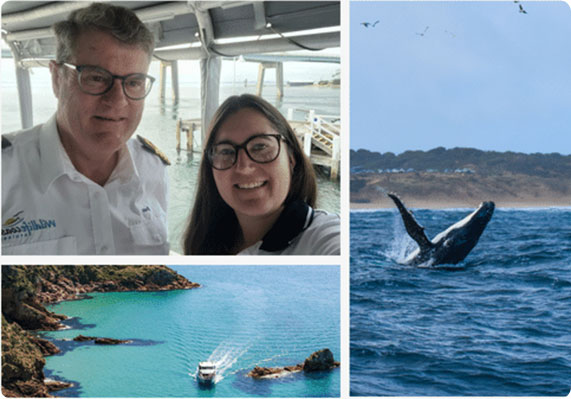
There were a lot of amazing takeouts from last week’s Destination NSW Visitor Economy Forum.
Of particular interest are the insights, trends, and data around what does, might, and will affect people and importantly people leadership.
The reminder about the significance of “Intergenerational Understanding” was critical with often up to 4 generations potentially working together. Just because it was and is for us, doesn’t mean it’s the same for the next generation or the one after that. As our industry evolves rapidly with technology, customer demands, and sustainability at the forefront, many will ignore generational differences with a cookie-cutter approach instead of developing an understanding to the nuances each generation has and how to adapt one’s leadership style and approach accordingly.
Currently, we have 27% of the workforce being Gen Z, 34% of Gen Y, 27% Gen X, and 12% being Baby Boomers.
Here’s a brief overview of some of the key characteristics and traits associated with different generations. Please note generations are often categorised based on shared experiences and cultural influences. It’s important to note that these characteristics are broad generalizations, and individuals within each generation may vary widely;
Builders / Silent Generation (born roughly 1928-1945):
Key Traits: Hardworking, disciplined, conformist.
Influences: Experienced the Great Depression and World War II, shaped by economic hardship and a sense of duty.
Baby Boomers (born roughly 1946-1964):
Key Traits: Optimistic, team-oriented, competitive.
Influences: Post-World War II economic boom, Civil Rights Movement, Vietnam War.
Generation X (born roughly 1965-1980):
Key Traits: Independent, entrepreneurial, skeptical.
Influences: Witnessed economic and political instability, the rise of technology, and the end of the Cold War.
Millennials (born roughly 1981-1996):
Key Traits: Tech-savvy, socially conscious, collaborative.
Influences: Rapid technological advancements, globalisation, economic recessions, and the rise of the internet.
Generation Z (born roughly 1997-2012):
Key Traits: Diverse, digital natives, socially aware.
Influences: Growing up in a highly connected and digital world, exposure to global issues, and increased focus on diversity and inclusion.
Generation Alpha (born roughly 2013-2025):
Projected Traits: Technology-dependent, global citizens, socially conscious.
Projected Influences: Growing up in an even more interconnected world, increased reliance on technology, and continued focus on global issues.
It’s essential to remember that these generational characteristics are generalisations, and individual differences exist within each group. Moreover, societal changes, technological advancements, and global events continually shape and influence generational traits. As time progresses, new generations will emerge with their own unique characteristics and perspectives.
Effectively leading and managing a diverse workforce that spans multiple generations requires a nuanced and adaptable approach.
Here are some general strategies that leaders can consider to work with and get the best out of different generations:
Understand Generational Differences:
Leaders should familiarise themselves with the general characteristics and preferences of each generation. Understanding the values, communication styles, and work preferences can help in tailoring leadership approaches.
Emphasise Clear Communication:
Different generations may have distinct communication preferences. While older generations may appreciate face-to-face communication, younger generations may prefer digital channels. Leaders should be adaptable in their communication methods to ensure effective understanding and engagement.
Promote Collaboration and Inclusivity:
Encourage a collaborative and inclusive work environment where individuals from different generations can learn from each other. Foster a culture that values diverse perspectives, experiences, and ideas.
Provide Professional Development Opportunities:
Recognise that different generations may have varied learning preferences. Offer a range of professional development opportunities, including mentorship programs, training sessions, and online resources, to accommodate diverse learning styles.
Flexibility in Work Arrangements:
Acknowledge that different generations may have different expectations regarding work-life balance and flexible work arrangements. Offering flexibility in work schedules and remote work options can enhance job satisfaction and productivity.
Recognise and Reward Diverse Contributions:
Tailor recognition and reward systems to acknowledge the diverse contributions of individuals from different generations. This can include both formal and informal recognition programs that cater to various preferences.
Provide Feedback Regularly:
Offer regular feedback and performance evaluations, taking into account the preferences of each generation. Some may prefer formal, scheduled feedback sessions, while others may appreciate more frequent, informal check-ins.
Embrace Technology:
Recognise the varying levels of tech-savviness across generations. Ensure that technological tools and platforms are accessible and user-friendly for all employees. Additionally, provide training and support for those who may need assistance.
Promote a Culture of Continuous Learning:
Foster a culture of continuous learning and development to appeal to the desire for growth and skill enhancement across all generations. This could include opportunities for cross-generational mentorship and reverse mentoring.
Lead by Example:
Demonstrate the values and behaviours that align with the organisation’s mission and goals. Leading by example can help build trust and respect across generations.
In essence, effective leadership involves recognising and leveraging the strengths of individuals from different generations. Leaders who can adapt their leadership styles, communicate effectively, and create inclusive environments are better positioned to harness the diverse talents within their teams.
What tweaks and adjustments might you make to ‘acknowledge’ and adapt to generational differences?
P.S Whenever you’re ready… here are 4 ways I can help you develop your tourism business leadership capabilities and achieve consistent business growth:
- Grab a free copy of our E-Book – How to Attract, Train and Retain Your Tourism Talent
It’s the core principles for success in attracting new tourism talent, training new and existing staff, then retention strategies to ensure you keep the keepers — Click Here
- Join the Tourism Business Leader’s Facebook group and connect with like-minded leaders focused on building highly effective teams
It’s our Facebook community where smart leaders get to learn more about creativity, leadership and performance for tourism business success. — Click Here
- Create Your Tourism Pro-Team and Drive Consistent Growth
Helping tourism business leaders develop their skills to improve engagement, accountability and performance of the team and business. If you’d like to work with me so you can stop being reactive, have the difficult conversations and drive performance to get the results you want and know the business need and can achieve then… message PRO to me here and I’ll get you all the details.
- Let’s get the Whole Team Together
Would you like a different perspective and someone else at the front of the room or on zoom/teams to lead regular and consistent team building, accountability, and engaging learning experiences, that drive results and outcomes for individuals, teams, and the business? If you feel a little challenged with everything going on, maybe sounding like a cracked record saying things repeatedly, or actually not 100% how to motivate and drive the team, given the current nature of business, it may be useful for us to chat. Message TEAM to me here… and tell me a little about the business, your team, and what you’d like to work on together.



